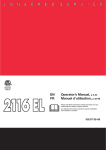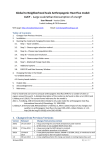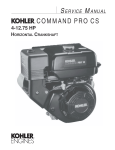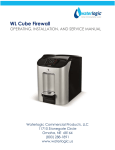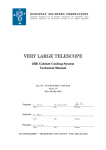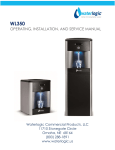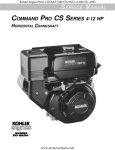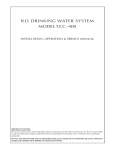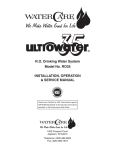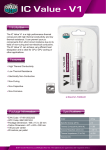Download REVERSE OSMOSIS DRINKING WATER SYSTEM
Transcript
REVERSE OSMOSIS DRINKING WATER SYSTEM INSTALLATION, OPERATION & SERVICE MANUAL Drink With Confidence! TABLE OF CONTENTS SECTION I. Page INTRODUCTION....................................................................................3 SECTION II. SPECIFICATIONS .................................................................................4 SECTION III. PREPARATION......................................................................................5 A. Typical Under Sink Installation Diagram..........................................5 B. Tools Recommended for Installation................................................7 C. Site Selection For Major System Components................................7 SECTION IV. INSTALLATION STEPS.........................................................................8 A. Faucet Installation............................................................................8 B. Feed Water Saddle Valve Installation..............................................8 C. Drain Clamp Installation...................................................................9 D. R.O. Manifold Assembly Installation................................................9 E. Position the Drinking Water Holding Tank and Make the Final Hose Connections..........................................10 F. Start Up..........................................................................................10 SECTION V. OPERATION AND MAINTENANCE....................................................11 A. Normal Operation...........................................................................11 B. Changing Filters.............................................................................11 C. Changing the In-Line Activated Carbon Post Filter........................12 SECTION VI. TROUBLE SHOOTING GUIDE............................................................16 EXPLODED VIEW AND PARTS LIST...................................................................................18 SECTION I. INTRODUCTION Your new Reverse Osmosis (R.O.) Drinking Water System uses a combination of filtration technologies to reduce unwanted contaminants in a water supply. The following steps combine to give you the best in clear sparkling drinking water: MECHANICAL FILTRATION–The Sediment Prefilter has been designed to reduce the larger particles such as silt, rust and scale. Its 5 micron (equal to 0.0002 inch) nominal rating helps to give maximum life to the R.O. Membrane. ACTIVATED CARBON–The Activated Carbon Prefilter contains carbon particles with a vast network of pores. The tremendous surface area of these pores (typically 800–1200 square meters per gram of carbon) gives the carbon very good adsorptive sites for substances that contribute to tastes and odors. The activated carbon in the Prefilter has been designed to reduce any chlorine that may be present in the feed water. This pretreatment is also necessary for membrane protection. REVERSE OSMOSIS MEMBRANE–The R.O. Membrane is the heart of the filtration system. It is designed to reduce the dissolved mineral content of the water. Minerals picked up in the environment by the water are measured as Total Dissolved Solids (TDS). In the Reverse Osmosis process, dissolved minerals are separated from the incoming water (Feed Water) to produce the product water (the Permeate). The excess minerals are rinsed to drain (the Reject Water). The membrane is a specially constructed, fully aromatic polyamide film, and is classified as a Thin Film Composite (T.F.C.). The spiral wound construction of the R.O. Membrane provides maximum surface area for water production and is less susceptible to fouling by particulate matter, turbidity and colloidal materials. IN–LINE ACTIVATED CARBON POST FILTER–The In–Line Activated Carbon Post Filter is located after the Holding Tank and has been designed to reduce the tastes and odors that may pass through the system. It adds a final polish to the water. AUTOMATIC SHUTOFF VALVE–The ASO Valve senses when the Holding Tank is full and closes the feed water supply to prevent excess reject water from going to drain when the unit is not producing water. IMPORTANT NOTICES: This reverse osmosis system contains replaceable treatment components critical for effective performance. It is the user's responsibility to, and the manufacturer strongly recommends that the user, periodically test the product water to verify the system is performing satisfactorily. DO NOT USE WITH WATER THAT IS MICROBIOLOGICALLY UNSAFE OR OF UNKNOWN QUALITY, WITHOUT ADEQUATE DISINFECTION BEFORE OR AFTER THE SYSTEM. 3 SECTION II. SPECIFICATIONS TABLE A – RECOMMENDED OPERATING LIMITS FOR FEED WATER Specifications Water Pressure TDS Temperature pH Hardness Iron Manganese Hydrogen Sulfide Chlorine Bacteria T.F.C. Membrane 40–100 psig (280–690 kPa) 2000 ppm (also mg/l) max. 40–100°F (4–38°C) 4–11 (optimum rejection at pH 7.0 - 7.5) Less than 10 gpg (170 mg/l) or soften Less than 0.1 ppm (also mg/l) Less than 0.05 ppm (also mg/l) None See note Must be potable** NOTE: Chlorine will damage a T.F.C. Membrane. The Activated Carbon Prefilter has been designed to reduce chlorine from the incoming water. Change filter every 6 to 12 months, more often if the water contains more than 1 ppm chlorine. **DO NOT USE WITH WATER THAT IS MICROBIOLOGICALLY UNSAFE OR OF UNKNOWN QUALITY, WITHOUT ADEQUATE DISINFECTION BEFORE OR AFTER THE SYSTEM. 4 SECTION III. PREPARATION A. TYPICAL UNDER SINK INSTALLATION DIAGRAM Close-up of Manifold IN AIN DISPENSING FAUCET WITH AIR GAP DR T AIN R DR ICTO R ST RE D RE K AC BL OU OW LL YE See Page 9 IN-LINE ACTIVATED CARBON POST FILTER COVER DRAIN (3/8" Black) PRODUCT (3/8" Blue) HOLDING TANK SHUTOFF VALVE (Open Position) RO MANIFOLD DRAIN CLAMP DRAIN (1/4" Black) INLET (1/4" Red) FEED WATER SADDLE VALVE (1/4" Yellow) (Cold Water Line Only) LOCATE DRAIN CLAMP ABOVE "P" TRAP DRINKING WATER HOLDING TANK POLYTUBE TEE TANK (3/8" Yellow) Figure 1 5 4" MIN REVERSE OSMOSIS MEMBRANE HOUSING ACTIVATED SEDIMENT CARBON PREFILTER PREFILTER HOUSING HOUSING OPTIONAL BASEMENT INSTALLATION DIAGRAM Close-up of Manifold IN DISPENSING FAUCET AIN DR T OU AIN R DR ICTO R ST RE D RE K AC BL OW LL YE See Page 9 NOTE: FOR REFRIGERATOR WATER DISPENSER OR ICE MAKER HOOKUP, TEE INTO 3/8" BLUE TUBING TO DISPENSING FAUCET. PRODUCT (3/8” Blue) HOLDING TANK SHUTOFF VALVE (Open Position) FLOOR TANK (3/8” Yellow) POLYTUBE TEE COVER IN-LINE ACTIVATED CARBON POST FILTER RO MANIFOLD DRINKING WATER HOLDING TANK (1/4" Yellow) FEED WATER SADDLE VALVE (COLD WATER LINE ONLY) INLET (1/4” Red) DRAIN (1/4” Black) 1” AIR GAP REQUIRED MOUNT HOLDING TANK ON SHELF OR STRAP BETWEEN FLOOR JOISTS (shelf or straps not included) REVERSE ACTIVATED SEDIMENT OSMOSIS CARBON PREFILTER MEMBRANE PREFILTER HOUSING HOUSING HOUSING PLEASE NOTE: IF AIR GAP IN FAUCET IS NOT USED IN BASEMENT INSTALLATIONS, A PROPER AIR GAP MUST BE CREATED. PLEASE CHECK WITH LOCAL PLUMBING CODES. SEE EXAMPLE ABOVE. BASEMENT FLOOR Figure 2 6 B. Tools Recommended for Installation open area beneath the faucet under the sink for attaching product and drain tubing are considerations. The following tools will cover most of the installation sites encountered: 2. Drinking Water Holding Tank–The Holding Tank may be placed where it is convenient within 10 feet of the faucet; under the sink or in an adjacent cabinet are best the choices. If a longer run of tubing is required, the tubing should be the 3/8" diameter OD size to prevent a high pressure drop. Remember, these tanks can weigh up to 30 pounds when full of water; a firm, level area is required. 1. 3/8" variable speed electric drill. 2. Extension work light with outlet. 3. Safety glasses. 4. Porcelain hole cutter kit. 5. Greenlee hole punch and 1/8" and ½" metal drill bits for pilot hole. 6. Center punch and hammer. 3. R.O. Manifold Assembly–The manifold can be installed on either the right or left side of the under–sink area or a cabinet. The right side is recommended because all the tubing will be to the back of the cabinet and out of the way. Installation in the basement is also an option; one location is near the laundry/utility sink where cold potable water and drain access are handy. The mounting location should allow adequate clearance and accessibility for cartridge changes. 7. Wood bit. 8. Concrete drill bits. 9. Assorted wood and metal drill bits including 7/ " metal drill bit. 32 10.Phillips head and flat blade screwdrivers. 11.½", 9/16" and 5/8" open end wrenches. 12.Teflon tape. 13.Wide masking tape or duct tape. 14.Plastic tubing cutter. 4. Feed Water Connection–The Feed Water Saddle Valve should be located as close to the manifold assembly as possible. USE A POTABLE COLD WATER SUPPLY ONLY. Softened water is preferred as it will extend the life of the R.O. Membrane. 15.Extra plastic tubing. 16.Low range air pressure gauge. 17.Bicycle hand air pump. 18.Small bottle of liquid chlorine bleach. 19.Graduated measuring cylinder. 5. Drain Connection–The waste water must go to drain through an anti–siphon air gap. The air gap may be provided in the base of the faucet. If discharging into a utility sink or standpipe, an air gap of greater than 1" above the flood rim must be provided. 20.Paper towels, wisk broom and assorted clean up materials. C. Site Selection for Major System Components The R.O. System was designed to fit under a sink, however, because of space limitations or other reasons, the system’s flexible design allows for other locations. When determining the location remember that access to a cold water tap line, the household drain, and ease of filter replacement are important considerations. All components and tubing should be located in an area not exposed to freezing temperatures. If winter temperatures are severe, the area should be above the minimum temperature listed in Table A, page 4 for proper performance. Do not expose unit or tubing to direct sunlight. 1. Dispensing Faucet–The faucet should be placed near the sink where drinking water is normally obtained. Convenience of use (filling of water pitchers and glasses), and an 7 Do NOT connect the system drain line to the dishwasher drain or near the garbage disposal. Backpressure from these units may cause the air gap to overflow. SECTION IV. INSTALLATION STEPS •Turn the Handle of the Feed Water Saddle Valve counter clockwise (outward) until the lance does not protrude from the gasket. It may have to be pushed in. All plumbing should be done in accordance with state and local plumbing codes. •Assemble the Feed Water Saddle Valve on the tubing. NOTE: Some codes may require installation by a licensed plumber; check with the local plumbing authority prior to installation. –for 3/8" OD tubing use the back plate side with the small groove to prevent distortion of the tubing. In restricted under–sink areas, it may be easier to install the faucet first. Allow adequate tubing lengths for any final component position. –for larger tubing (up to 5/8" OD) use the large groove of the back plate. •Assemble and tighten the brass screw. A. Faucet Installation This system does not include a faucet. Select a faucet that has a 3/8" tubing connection and install per faucet manufacturer's instructions. Connect 3/8" blue tubing to faucet treated water port and if using air gap faucet connect 1/4" and 3/8" black tubing. •To pierce the tubing, turn the Valve Handle fully clockwise (inward). A small amount of water may escape from the outlet until it is fully pierced. •When you feel the Valve Handle firmly seated in the clockwise direction, the copper tube is pierced and the valve is closed. FEED WATER SADDLE VALVE 2b. To install on (hard) steel or brass tubing supply line. Cold Water Line Saddle •The supply line should now be drained. Use a battery powered or properly grounded drill to avoid shock hazard. Reversible Back Plate •Drill a 3/16" hole in the supply line; (do not drill through the opposite wall). Valve Handle Tightening Screw •Turn the handle to expose the lance no more than 3/16" beyond the rubber gasket. Insert •Place the body of the valve over the hole so that the lance fits into the hole. Plastic Ferrule •Assemble and tighten the brass screw. Compression Nut •Turn the Valve Handle clockwise (inward) until firmly seated. The valve is closed. Red Tubing To Manifold Inlet 3. With the Feed Water Saddle Valve closed, open the sink faucet and the water supply and allow the water to run for a few minutes to flush any debris caused by the installation. Figure 3 B. Feed Water Saddle Valve Installation •Close the faucet and check the Feed Water Saddle Valve for leaks. Decide on location. Do NOT connect to a hot water feed line. If you are not sure of the supply, run the hot water and feel the supply piping. Water over 100°F may cause permanent damage to the R.O. Membrane. (Refer to Fig. 3) 1. Shut off the water supply and drain the line. 2a.To install on (soft) Copper Tubing supply line: 8 3/8" DRAIN CLAMP ASSEMBLY Drain Pipe D. R.O. Manifold Assembly Installation Locate the site per Sec. III, C.3. Various installation sites will require different types of mounting fasteners; be sure the fastener selected will provide a firm, solid mounting. A support panel may be necessary on thin cabinet walls or to span between wall studs on particleboard or drywall. Do not drill through exterior cabinet walls or leave sharp wood screw points exposed in readily accessible cabinet interiors. The close proximity of a dishwasher or a trash compactor may require special fabrication of a mounting plate. 1/4" Nut Drain Clamp Front Plate 1/4" Screw Drain Clamp Back Plate Black Drain Tubing 1. The mounting bracket will accept either #10 or #12 (5mm) mounting screws spaced on 6" (15 cm) centers. Allow at least 4" (10 cm) of clearance beneath the filter housings to accommodate filter changes. Mark the two locations (the bracket can be used as a template). Install the screws and tighten them until the heads are about 5⁄8" from the wall. Figure 4 C. Drain Clamp Installation Choose the drain outlet location per Sec. III, C.5. The following are instructions for discharging into the sink drain pipe. (Refer to Fig. 1.) 1. Position the Drain Clamp on the sink drain pipe above the drain trap. Allow room for drilling. Tighten securely. 2. Use a battery powered or properly grounded drill. Using the Clamp port as a drill guide, drill a 7/32" hole through the wall of the drain pipe. Do NOT penetrate the opposite side of the pipe. IN T D CAUTION: The lowest point of the line should be the point of connection to the Drain Clamp. There should be no sag in the line as this may cause excessive noise as the reject water is flowing to drain. OU K AC BL OW LL YE 3. Locate the Black Drain Tubing connected to the Dispensing Faucet. Route to the tubing to the Drain Clamp and trim to length. NOTE: When cutting the polytubing make clean, square cuts, failing to do so could result in poor connections and possible leaks. AIN R DR ICTO R ST RE RE 3/ " 8 AIN DR 2. Locate the ¼" Red Feed Water Tubing. Remove the red plug from the fitting labeled “In” on the manifold and insert the tubing. Reference the special supplement sheet in the carton for proper connection of all tubing and removal of plugs. Run the tubing along its course to the Feed Water Saddle Valve, trim to length. (Refer to Fig. 1.) •Refer to Fig. 4. Insert the tubing into the Drain Clamp. Make sure the tubing is pressed all the way in to create a pressure tight connection. Refer to Fig. 3. To the end of the red polytube install the Compression Nut, the Plastic Ferrule, and the Insert. Connect to the Feed Water Saddle Valve. 3. Locate the ¼" Black Drain Tubing connected to the Dispensing Faucet. Remove the black plug from the fitting labeled “Drain” on the manifold. The end of the Black Drain Tubing that should be inserted into the “Drain” port will have a drain restrictor in it. Allow the tubing to relax, then press drain restrictor firmly again to insure proper seating. NOTE: If you want to pull the tubing out for some reason, push the ring around the tubing in and pull the tubing out. 9 1. Sanitizing the system. Use a drip pan to aid clean–up. 4. Locate the ¼" yellow tubing with the tee attached to one end. Remove the yellow plug from the fitting labeled "Out" on the manifold and insert the tubing. E. Position the Drinking Water Holding Tank and Make the Final Hose Connections. •Use a good quality unscented 5¼% liquid chlorine household bleach. 1. Check the tank precharge pressure. Make sure it is between 5 to 7 psig. If not, use a bicycle hand pump or other pump to bring the pressure up to the 5 to 7 psig range. •Open the Dispensing Faucet and open the Holding Tank Shut–Off Valve (the handle should be parallel with the valve body). 2. Pull the cap/plug off the top of the tank where the Tank Shut–Off should go. (Refer to Fig. 1.) •Remove the plug on the underside of the manifold labeled “SEDIMENT”. Pour one capful of bleach (this is approximately 2 tsp. or 10 ml) into one of the white Housings. AVOID GETTING BLEACH ON THREADS AND O-RINGS. Insert a Housing O–ring into the Housing groove, (press firmly in place). Engage and firmly tighten the Housing hand tight only. 3. Wrap Teflon tape three times around the ¼" male outlet thread. Wrap in the direction of the threads (clockwise when looking down on the Holding Tank). The tape will act as a thread sealant. Screw on the Holding Tank Shut–Off Valve. 4. Locate the 3⁄8" Yellow Tubing. Firmly press one end into the Holding Tank Shut–Off Valve and the other end into the tee. (Refer to Fig. 1.) The fittings will grab the tubing and seal it in place. Make sure the tubing is pressed all the way in to create a pressure tight connection. •Remove the plugs labeled “ACTIVATED CARBON” and “MEMBRANE” from the underside of the manifold. To each of the remaining white Housings, add one capful of bleach. AVOID GETTING BLEACH ON THREADS AND O-RINGS. Insert a Housing O–ring, engage and firmly tighten the Housings hand tight only. 5. Locate the 3⁄8" Blue Product Water Tubing attached to the Dispensing Faucet. Firmly press one end into the tee. (Refer to Fig. 1.) The fittings will grab the tubing and seal it in place. Make sure the tubing is pressed all the way in to create a pressure tight connection. •Slowly open the Feed Water Saddle Valve (turning counter clockwise). •As soon as the water begins to come out of the Dispensing Faucet, close the Faucet. 6. Hang the Manifold Assembly on the mounting screws and tighten. DO NOT OVERTIGHTEN. •Let stand for 15 minutes. NOTE: During this time, check the system carefully for leaks. 7. Remove the wrapping from the In–Line Activated Carbon Post Filter. Slice the 3/8" Blue Polytube where it would be convenient to install and change the In–Line Filter. Make a clean straight cut to insure proper connections. The “Out” port on the In–Line Filter should be towards the faucet. Firmly press in the tubing. The fittings will grab the tubing and hold and seal it in place. Make sure the tubing is pressed all the way in to create a pressure tight connection. •At the end of 15 minutes, CLOSE the Feed Water Saddle Valve and open the Dispensing Faucet. •Allow the Holding Tank to completely drain, then remove the Sediment Prefilter Housing (the farthest of the three from the In–Out ports), empty, and install the Sediment Prefilter. Firmly tighten the Housing hand tight only. •Remove the Activated Carbon Prefilter Housing (the middle one), empty, and install the Activated Carbon Prefilter. Firmly tighten the Housing hand tight only. F. Start Up NOTE: The system should be sanitized BEFORE installing the Sediment Prefilter, the Activated Carbon Prefilter or the RO Membrane. At time of start up and each time the filters are changed the system should be sanitized (also see Operation and Maintenance Sec. V, B.1–4). 10 Holding Tank is full and no water is being used, the ASO Valve will automatically shut off the feed water to conserve water. The more water that is used (up to the capacity of the system) the better the R.O. system will function. Other uses for the water are flowers, pets and rinsing glassware. 2. Installing the R.O. Membrane: •Remove the R.O. Membrane Housing, (the closest of the three to the In-Out ports), and empty. •Insert the Membrane up into the manifold. (The O–rings should be up toward the manifold.) Check the Housing O–ring for proper position in its groove, engage and firmly tighten the Housing hand tight only. 3. Rinsing the system: •Slowly open the Feed Water Saddle Valve fully counter clockwise. •The Holding Tank Valve should be open. •Check the Air Gap Window on the Dispensing Faucet to be sure that the drain water is flowing. The R.O. System is now making water. With each use it is recommended that you run the faucet for at least 10 seconds prior to using water. This is especially important if the system has not been used daily. After periods of non–use, such as a week of vacation, it is better to empty the Holding Tank and allow the system to produce fresh water for use. If the system is not used for 3–4 weeks or longer, it is a good idea to resanitize the system and to change the prefilter and post filters. B. Changing Filters •Do not open the Faucet for at least 8 hours. •Do not use the first three full tanks of water. CAUTION: The R.O. Membrane is shipped with a preservative in it. To ensure proper rinsing of the R.O. Membrane it is important to wait at least 8 hours before emptying each tank. When the Faucet is first opened, expect air and carbon fines (very fine black powder) from the In–Line Activated Carbon Post Filter to be rinsed out. This is normal for the first tank of water or after the Activated Carbon Post Filter is changed. SECTION V. OPERATION & MAINTENANCE A. Normal Operation 1. It is normal for the Total Dissolved Solids (TDS) of the water to be higher than normal during the first 5 gallons of operation; this is due to the sanitizing solution and the new Post Filter. After this water is rinsed to drain, the removal rate should stabilize at a value of greater than 75%. THIS R.O. SYSTEM CONTAINS FILTERS WHICH MUST BE REPLACED AT REGULAR INTERVALS TO MAINTAIN PROPER PERFORMANCE. USE ONLY FACTORY APPROVED FILTERS. All individuals should take adequate precautions when changing the filters, including wearing protective gloves, to avoid direct contact with the exhausted filters. The recommended interval for changing the filters (not the R.O. Membrane) is every 6 to 12 months. Typical T.F.C. Membrane life expectancy is three years. Local conditions may dictate more frequent changes. NOTE: If the R.O. Membrane is to be replaced, see Sec. IV, F.1–3, for the proper procedure. Use a drip pan to catch any water that may spill when the Filter Housings are removed. Refer to Fig. 1 for component location. 1. Close the Feed Water Saddle Valve by turning fully clockwise and open the Dispensing Faucet. Allow the Holding Tank to empty. 2. R.O. systems produce drinking water at relatively slow rates; it can take up to 5 hours or more to fill the Holding Tank. Normal operation is to let the Holding Tank fill with water and then draw water as is needed. When the pressure in the Holding Tank falls to a given pressure (as the water is being used) the Automatic Shut–Off Valve (ASO Valve) will start water production and the system will refill the Holding Tank. When the 2. Loosen and remove the Sediment Prefilter and the Activated Carbon Prefilter Housings. Discard the filters. 3. Wash the inside of the Housings using a mild detergent and a soft cloth. Do not use abrasive cleaners or pads. Thoroughly rinse all soap from the Housings before reassembly. 11 •Do not open the Faucet for at least 8 hours. 4. To sanitize the system and replace the filters: NOTE: The system should be sanitized before installing the Sediment Prefilter and Activated Carbon Prefilter. •Discard the first three full tanks of water produced, they will contain chlorine. •Use a good quality unscented 5¼% liquid chlorine household bleach. IN–LINE ACTIVATED CARBON POST FILTER ASSEMBLY •Add one capful of bleach (this is 2 tsp. or 10 ml) to the Sediment Prefilter Housing and temporarily install the Housing without the Sediment Prefilter. AVOID GETTING BLEACH ON THREADS AND O-RINGS. Check the Housing O–ring for proper position in its groove, engage and firmly tighten the Housing hand tight only. To Dispensing Faucet 3/8" Blue OUT •Add one capful of bleach to the Activated Carbon Prefilter Housing. AVOID GETTING BLEACH ON THREADS AND O-RINGS. Carefully fill the Housing with tap water and temporarily install the Housing without the Activated Carbon Prefilter. IN 3/8" Blue In-Line Activated Carbon Post Filter Figure 5 C. Changing the In–Line Activated Carbon Post Filter •The Dispensing Faucet should be open, slowly open the Feed Water Saddle Valve. 1. Close the Feed Water Saddle Valve by turning fully clockwise. •As soon as water begins to drip out of the Dispensing Faucet, close the Faucet. 2. Close the Holding Tank Valve and then open the Dispensing Faucet to release the pressure. •Let the system stand for 15 minutes. •At the end of 15 minutes, in the following order, close the Feed Water Saddle Valve, close the Holding Tank Valve and open the Dispensing Faucet to release the pressure. 3. Remove the In–Line Activated Carbon Post Filter. Disconnect the used Post Filter by pressing in the connector’s collar and at the same time pulling the tube out of the fitting. •Remove the Sediment Prefilter Housing and empty. Remove the wrapping and install the Sediment Prefilter. Firmly tighten the Housing hand tight only. 4. Firmly reconnect the polytubes to the new Post Filter. (Refer to Fig. 5.) Make sure the tubing is pressed all the way in to create a pressure tight connection. •Remove the Activated Carbon Prefilter Housing and empty. Remove the wrapping and install the Activated Carbon Prefilter. Firmly tighten the Housing hand tight only. NOTE: If you want to pull the tubing out for some reason, push the ring around the tubing in and pull the tubing out. 5. Slowly open the Feed Water Saddle Valve. •Disconnect the yellow product water tubing that runs from the Holding Tank to the Tee (see Fig. 1). Put 50 drops of bleach (this is ½ tsp. or 3 ml) into the tubing and reconnect it to the Tee. 6. When water begins dripping out of the Faucet, in the following order, close the Faucet and open the Holding Tank Valve. When the Faucet is first opened, expect air and carbon fines (very fine black powder), from the new Post Filter to be rinsed out. This is normal for the first tank of water. NOTE: Now is the convenient time to change the In–Line Activated Carbon Post Filter, see Sec. V, C.1–6. •Slowly open the Feed Water Saddle Valve. When water begins dripping out of the Dispensing Faucet, in the following order, close the Faucet and then open the Holding Tank Valve. 12 NOTES: 13 NOTES: 14 NOTES: 15 SECTION VI. TROUBLE SHOOTING GUIDE Problem Low quantity of Product Water from Holding Tank Possible Cause Solution Feed Water Saddle Valve is plugged or Open Valve or unclog. closed. Clogged Sediment Prefilter or Replace Filters. Activated Carbon Prefilter. Low water pressure. Feed Water pressure must be above 40 psig. R.O. Membrane is fouled. See Feed Water operating limits. Correct cause of fouling, replace Membrane. Plugged In–Line Activated Carbon Post Replace Post Filter. Filter. Air precharge pressure in Holding Empty water from Holding Tank, Tank is too high. and with the faucet open, adjust air pressure to 5–7 psig (35–48 kPa) range. Air precharge is too low Air bladder in the Holding Tank is Replace tank. ruptured. Holding Tank Valve is closed. Open Valve. No drain flow, the drain Drain Restrictor Clear or replace Drain Restrictor. is plugged. No drain flow, the drain orifice in the Clear or replace the Dispensing Dispensing Faucet is plugged. Faucet. The Check Valve is stuck. Free check. The ASO Valve is malfunctioning. Replace ASO Valve components. Low pressure at the Dispensing In–Line Activated Carbon Post Filter is Replace Post Filter. Faucet plugged. Air precharge in the Holding Tank is too Empty water from Holding Tank and low. with the faucet open, adjust the air pressure to 5–7 psig (35–48 kPa) range. Check for leakage at the Air Valve Stem. Holding Tank Valve is partially closed. Open Valve. The Dispensing Faucet is out of Repair or replace Dispensing Faucet. adjustment or faulty. Heavy water use, Holding Tank is Allow Holding Tank to refill (adding depleted. a second Holding Tank will increase storage capacity). Low Water Production. See Low Quantity of Product Water from Holding Tank section above. Replace Filters. High Total Dissolved Solids (TDS) in Clogged Sediment Prefilter or Activated Carbon Prefilter. the Product Water Low Water Pressure. Feed Water Pressure must be above 40 psig. Check Feed Water Saddle Valve. R.O. Membrane O–ring is crimped. Check O–ring. R.O. Membrane brine seal is not Check the brine seal. sealing up into the manifold head. R.O. Membrane is expended. If Membrane life is unusually short, find and correct the problem. Replace Membrane. 16 Problem High Total Dissolved Solids (TDS) in the Product Water (continued) Tastes and odors in the Product Water Drain Water overflows at the Dispensing Faucet Faucet leaks or drips Fitting leaks in general Possible Cause The Product Water and Drain Water lines are reversed. No drain flow, Drain Restrictor is clogged. No drain flow, the drain orifice in the Dispensing Faucet is plugged. The ASO Valve is not closing. Solution Correct plumbing. Clear or replace Drain Restrictor. Clear or replace Dispensing Faucet. Repair or replace the ASO Valve Components New In-Line or Activated Carbon Flush with several full tanks of Prefilter not rinsed completely. Product Water. The Feed Water TDS has increased. An increase in Feed Water TDS will give a corresponding increase in Product Water TDS. The In-Line or Activated Carbon Replace Filter. Prefilter is exhausted. There is foreign matter in the Holding Clean, flush and sanitize the system. Tank. Replace the filters. The Product Water and Drain Water Correct plumbing. lines are reversed. Dissolved gasses in the Feed Water. Pretreat Feed Water to remove dissolved gasses. Increase in Product Water TDS. See high TDS in the Product Water section. Air Gap is blocked. Clear Air Gap. Rinse with vinegar for removal of calcium buildup. Drain tubing is clogged. Clear tubing. Drain Clamp hole is misaligned. Align with hole in the drain pipe. Excessive drain flow rate. Replace Drain Restrictor. Leaks from base of the delivery O–ring is bad, replace O–ring. tube. Close the Feed Water Saddle Valve and relieve pressure before disconnecting any tubing or replacing any fitting. Before replacing a fitting, re–cut the tubing and re–insert into the fitting to see if that solves the leak. If pipe threads are leaking, remove and retape with Teflon tape. 17 EXPLODED VIEW & PARTS LIST 1 2 3 4 5 6 7 IN OUT 8 20 9 10 15 21 11 16 12 17 13 19 18 Sediment Prefilter Membrane MADE IN USA Carbon Prefilter 18 14 DRAWING NO. PART NO. DESCRIPTION 1.....................CS2009.......................... Self Tapping Screw 2.....................CS2005.......................... ASO Cap 3.....................CS2013........................... ASO Cap O–Ring 4.....................CS2011........................... ASO Diaphragm – Large 5.....................CS2007.......................... ASO Piston 6.....................CS2006.......................... ASO Piston Ring 7.....................CS2010........................... ASO Diaphragm – Small 8.....................CNSTFC0412MNG-WR. Manifold Plate Assembly (Includes diagram numbers 1-10 and 15 and 16.) 9.....................CS1276.......................... Check Valve 10.....................CS1277......................... Check Valve Retainer 11.....................CS7111.......................... Sediment Prefilter 12.....................CS7125........................ Activated Carbon Prefilter 13.....................CS3069........................ Housing O–Ring 14.....................CS3010BLK................... Housing 15.....................CJG-PI0808S............... 1/4" Plug 16.....................CS2116–12.................... Drain Restrictor 125 GPD/473 lpd 17.....................CS1774RS..................... T.F.C. RO Membrane 100 gpd/379 lpd 18.....................CS1405........................ 1/4"–3/8" Fitting Wrench 19.....................CS3072........................ Wrench for Housing 20.....................CS7206C-JG................ In-Line Activated Carbon Post Filter 21.....................CS2122-01................... Black Cover CC1999F-BLK.............. 4.4 Gallon Tank (Not Shown) 19 R.O. DRINKING WATER SYSTEM FIVE/ONE YEAR LIMITED WARRANTY What Does This Warranty Cover? This warranty covers any defects in materials and workmanship of the ClearFlo R.O. Drinking Water System when installed and operated within recommended parameters, with the exceptions stated below. How Long Does The Coverage Last? Water-Right will warrant its ClearFlo R.O. Drinking Water System (except for the reverse osmosis membrane), for a period of five years from the date of purchase. The reverse osmosis membrane is warranted for one year from date of purchase. All implied warranties including merchantability and fitness for a particular purpose are limited to five years from the date of purchase for the ClearFlo R.O. Drinking Water System, except for the reverse osmosis membrane which is limited to one year from date of purchase. Some states do not allow limitations on how long an implied warranty lasts, so the above limitations may not apply to you. What Will The Manufacturer Do? Water-Right will repair or replace at its discretion any defective component. You must pay any labor charges. You must also pay for shipping or travel charges to return the defective part(s). What Does This Warranty Not Cover? This warranty does not cover the disposable sediment and carbon filters whose service life depends on feed water conditions. In addition, the membrane is only warranted if the required feed water conditions are met. The above warranty will also not apply to any part of the ClearFlo R.O. Drinking Water System that is damaged because of neglect, misuse, alterations, accident, misapplication, physical damage, or damage caused by fire, acts of God, freezing or hot waters or similar causes. Consequential and incidental damages are not recoverable under this warranty. Some states do not allow the exclusion or limitation of incidental or consequential damages, so the above limitation or exclusion may not apply to you. We recommend that you use only authorized ClearFlo replacement parts since improper parts or incorrectly performed maintenance or repair voids this warranty. How Do You Get Service? In order to be eligible for service under this warranty you must (a) contact your local dealer who supplied the unit or (b) contact Water-Right for the dealer nearest you. How Does State Law Apply? This warranty gives you specific legal rights and you may also have other rights which vary from state to state. Manufactured by: Water-Right, Inc. 1900 Prospect Ct. • Appleton, WI 54914 Phone: 920-739-9401 • FAX: 920-739-9406 Form No. S1474WR-01 • 6/1/2015























